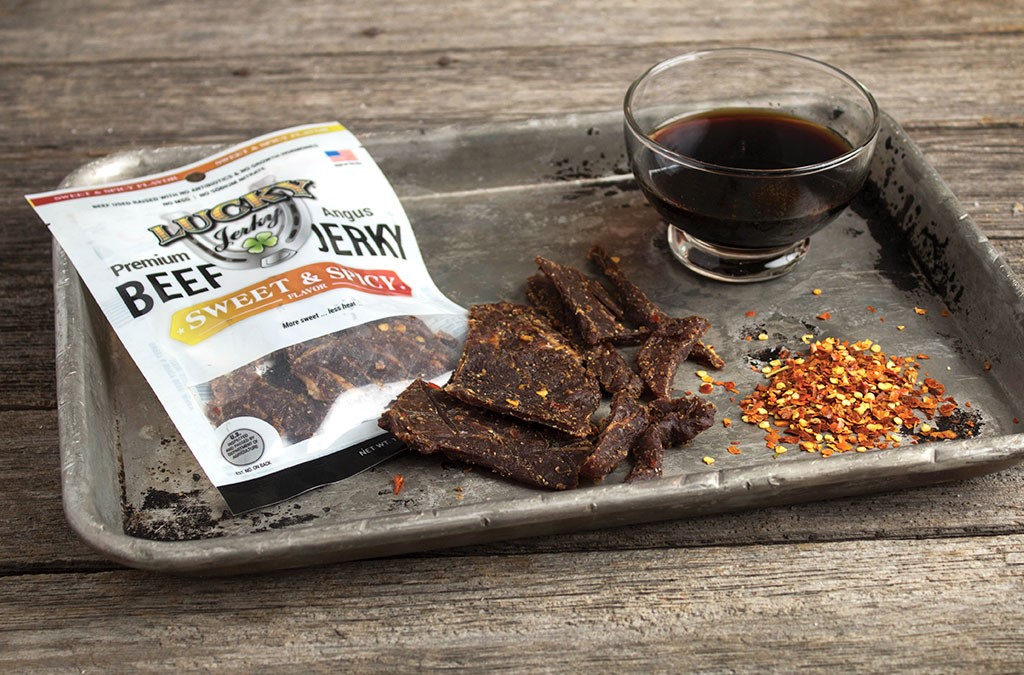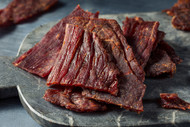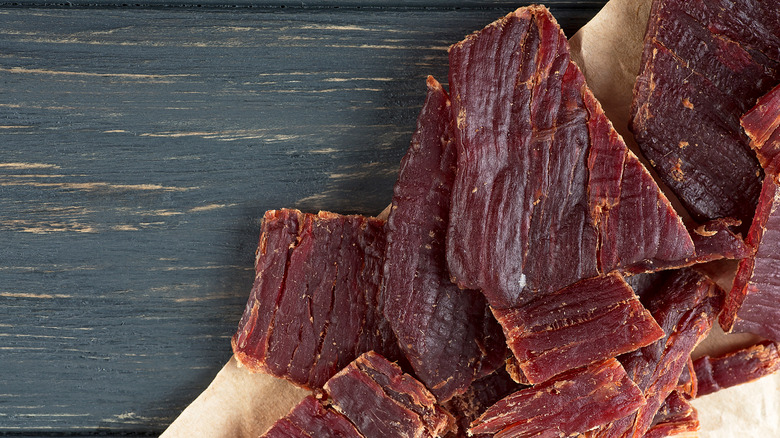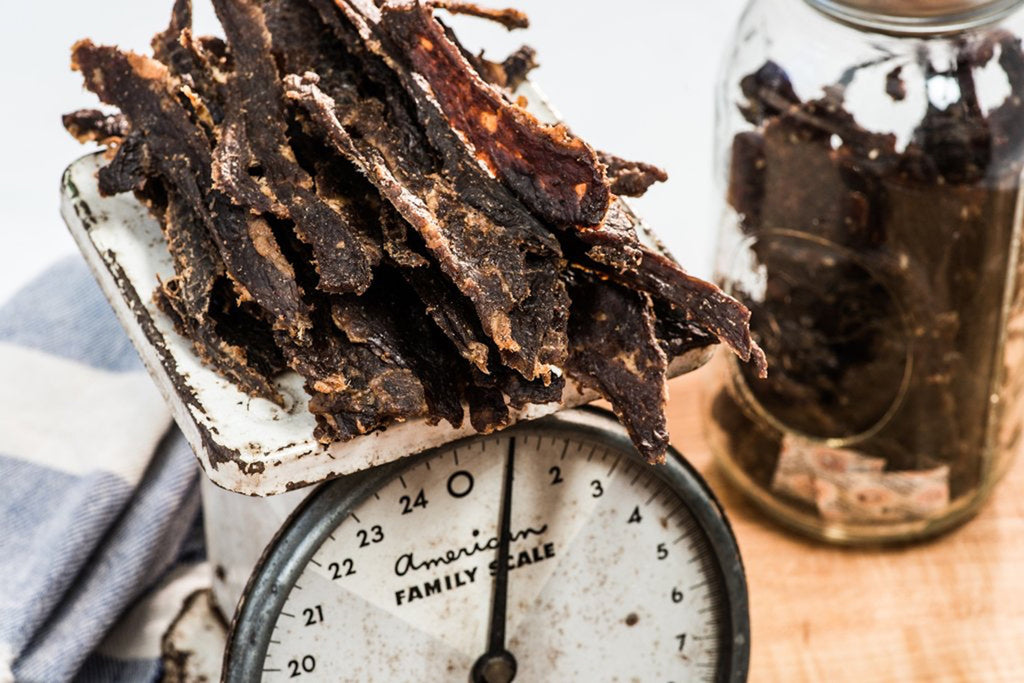History Of Beef Jerky

Beef jerky has a rich history that dates back thousands of years. It is believed to have originated as a method of preserving meat, allowing nomadic tribes and travelers to have a protein-rich food source that would last for extended periods of time. The process of making jerky involved marinating strips of beef in salt and drying them in the sun or over a fire. Over time, the methods of production and flavorings used in beef jerky have evolved, resulting in the diverse range of options available in today’s market. In recent years, beef jerky has gained popularity as a high-protein snack, contributing to its continued demand and relatively high price.
History Of Beef Jerky As A Preserved Food
Beef jerky has a long history as a preserved food. It is believed to have originated as a method of preserving meat for nomadic tribes and travelers who needed a portable and long-lasting source of protein. The process of making jerky involved marinating strips of beef in salt and drying them in the sun or over a fire. This method allowed the meat to be preserved for extended periods without refrigeration. Over time, the production methods and flavorings used in beef jerky have evolved, resulting in the diverse range of options available today.
Evolution Of Beef Jerky Production Methods
Over time, the production methods for beef jerky have evolved, allowing for improvements in taste, texture, and preservation. In the past, beef jerky was made by marinating strips of beef in salt and drying them in the sun or over a fire. However, advancements in technology have led to the development of more efficient production methods. Nowadays, beef jerky is often made using specialized dehydrators or smokehouses, which provide controlled and consistent drying conditions. Additionally, new techniques such as using vacuum sealing and nitrogen flushing have been introduced to enhance the shelf life and quality of beef jerky. These advancements have resulted in a wider variety of flavors and textures for consumers to enjoy.
Factors Affecting Beef Jerky Pricing

There are several factors that contribute to the pricing of beef jerky. One important factor is the quality of beef used in the production process. Higher-quality beef tends to be more expensive, resulting in a higher price for the final product. Additionally, the seasoning and marinating processes can also impact the pricing. Jerky that undergoes more extensive seasoning and marinating may have a higher price due to the additional time and ingredients involved. Overall, the quality of ingredients and the level of preparation contribute to the pricing of beef jerky.
Quality Of Beef Used In Jerky Production
The quality of beef used in jerky production plays a significant role in determining its price. Higher-quality beef, often sourced from grass-fed or organic sources, tends to be more expensive due to its superior taste and nutritional value. These premium cuts of beef are leaner and contain less fat, resulting in a healthier and more flavorful jerky. Additionally, the use of high-quality beef ensures the absence of additives or fillers, further adding to its value. The commitment to using top-notch beef in jerky production contributes to its higher price but guarantees a superior snacking experience.
Impact Of Seasoning And Marinating Processes On Pricing
The impact of seasoning and marinating processes on the pricing of beef jerky is substantial. These processes play a crucial role in enhancing the flavor and texture of the jerky, making it a more enjoyable snack. However, the use of high-quality spices, seasonings, and marinades adds to the cost of production. These ingredients are carefully selected to create the perfect balance of flavors and enhance the overall taste experience. The additional cost associated with these premium ingredients ultimately contributes to the higher price of beef jerky.
Production Costs Of Beef Jerky

The production costs of beef jerky play a significant role in its pricing. A breakdown of these costs includes the expenses associated with the quality beef used, the seasoning and marinating processes, packaging, and marketing. The use of high-quality beef adds to the overall cost, as well as the meticulous selection of spices and marinades to enhance flavor. Additionally, packaging and marketing efforts contribute to the final price. All these factors, along with the labor and equipment costs involved in production, contribute to the higher price of beef jerky compared to other snacks.
Cost Breakdown Of Beef Jerky Production
The cost breakdown of beef jerky production involves various expenses that contribute to its higher price. Firstly, the use of high-quality beef accounts for a significant portion of the production cost. Selecting premium cuts of meat ensures better flavor and texture in the final product. Additionally, the process of seasoning and marinating the beef requires the careful selection and blending of spices, which adds to the overall cost. Packaging materials, such as high-quality bags or vacuum-sealed packs, also contribute to the expenses. Lastly, marketing efforts, including branding and advertising, increase the overall production costs.
Influence Of Packaging And Marketing On Final Price
Packaging and marketing play a significant role in determining the final price of beef jerky. High-quality packaging materials, designed to preserve the freshness and extend the shelf life of the product, can significantly increase production costs. Additionally, packaging that enhances the product’s overall appeal, such as visually appealing designs and convenient sizes, can also contribute to a higher price point.
Furthermore, marketing efforts, including branding and advertising, incur expenses that are incorporated into the product’s price. Building a strong brand identity and promoting the product through various channels, such as social media and advertisements, requires investment. These marketing expenses are reflected in the final price of beef jerky.
Effective packaging and marketing strategies not only enhance the perceived value of the product but also attract consumers who are willing to pay a premium for a well-presented and well-branded beef jerky. Such strategies contribute to the overall cost and subsequently influence the final price of beef jerky.
Branding And Market Demand

Branding plays a crucial role in determining the pricing of beef jerky. Companies invest in creating a strong brand identity, which includes factors like product packaging, logo design, and brand reputation. A well-established brand commands higher prices, as customers perceive it to be of superior quality. Moreover, branding can create a sense of trust and familiarity, leading to repeat purchases and customer loyalty.
Market demand also influences the pricing of beef jerky. If there is high demand and limited supply, companies can justify charging higher prices. Additionally, market trends, such as an increased interest in protein-rich snacks or a growing preference for organic and natural products, can also impact pricing. Understanding and tapping into these market demands allows companies to optimize their pricing strategies and cater to the evolving preferences of consumers.
Overall, branding and market demand contribute to the perceived value of beef jerky and can justify its higher price point.
Effect Of Branding On Beef Jerky Pricing
Branding plays a significant role in determining the pricing of beef jerky. Companies invest in creating a strong brand identity, including product packaging, logo design, and brand reputation. A well-established brand commands higher prices as customers perceive it to be of superior quality. Moreover, branding creates a sense of trust and familiarity, leading to repeat purchases and customer loyalty. Strong brands have the power to differentiate themselves from competitors and justify a higher price point. Therefore, the branding efforts put into beef jerky contribute to its perceived value and can justify its higher price.
Market Demand Trends And Their Impact On Pricing
Market demand plays a crucial role in determining the pricing of beef jerky. The popularity of beef jerky has been on the rise in recent years, with a growing number of consumers seeking convenient and protein-packed snacks. This increased demand puts pressure on manufacturers to meet the supply, which can drive up the price of beef jerky. Additionally, fluctuations in the overall meat market and the availability of specific cuts of beef can also impact pricing. As consumer demand continues to grow, the pricing of beef jerky may remain higher due to the ongoing supply and demand dynamics.
Alternatives To Beef Jerky

There are alternatives for those who are looking for a different snack option. While beef jerky is popular, there are other meat snacks available that may offer a more budget-friendly option. For example, pork and turkey jerky can be less expensive than beef jerky while still providing a similar taste experience. Additionally, there are plant-based jerky alternatives for those who prefer a vegetarian or vegan snack. These alternatives use ingredients like mushrooms, soy, or seitan to replicate the texture and flavor of traditional jerky. Exploring these alternatives can provide a variety of options for consumers with different dietary preferences and budget constraints.
Comparison Of Beef Jerky Pricing With Other Meat Snacks
When comparing the pricing of beef jerky to other meat snacks, it becomes evident that beef jerky tends to be more expensive. For example, pork and turkey jerky can often be found at a lower price point than beef jerky, offering a similar taste experience at a more budget-friendly cost. While beef jerky is known for its rich flavor and high protein content, these alternative meat snacks provide a great alternative for those looking to save some money without compromising on quality and taste. Additionally, exploring plant-based jerky alternatives can provide even more affordable options for those with dietary preferences or restrictions.
Exploring Plant-based Jerky Alternatives
In recent years, there has been a growing trend towards plant-based diets, and this has paved the way for plant-based jerky alternatives. These alternatives are made from various plant protein sources such as soy, seitan, mushrooms, and jackfruit. They offer a similar texture and flavor profile to traditional beef jerky, making them a popular choice among vegans, vegetarians, and those looking to reduce their meat consumption. Plant-based jerky options are often more affordable than beef jerky, making them a budget-friendly alternative for those seeking a healthier and more sustainable snack option.
Conclusion

In conclusion, the high cost of beef jerky can be attributed to several factors. The use of higher-quality ingredients and the labor-intensive production process contribute to its premium price. Additionally, the impact of branding and market demand also influences the pricing of beef jerky. However, for those seeking a more affordable and sustainable alternative, plant-based jerky options offer a budget-friendly and equally delicious alternative. As the trend towards plant-based diets continues to grow, these alternatives provide a promising future for jerky enthusiasts. So whether it’s traditional beef jerky or plant-based alternatives, there’s a snack option for everyone to enjoy.
Summary Of Reasons Behind Beef Jerky’s Pricing
Beef jerky’s high pricing can be attributed to several factors. Firstly, the use of higher-quality beef raises the production cost. Jerky also undergoes a labor-intensive process of marinating, seasoning, and dehydration, increasing the overall expenses. Additionally, the impact of packaging and marketing adds to the final price. Branding plays a crucial role in creating a premium image, which affects the pricing strategy. Market demand also influences the cost, as consumers are willing to pay more for this popular snack. Despite the expensive nature of traditional beef jerky, plant-based alternatives offer a more budget-friendly option for those seeking affordability.
Future Outlook For Beef Jerky Market And Pricing Trends
The future outlook for the beef jerky market appears promising, with continued growth expected due to the snack’s popularity and increasing consumer demand for convenient, protein-rich snacks. As more people are embracing healthy and on-the-go snacking options, beef jerky is likely to maintain its strong market presence. However, pricing trends may vary depending on factors such as the cost of beef, production techniques, and competition in the market. Producers might explore cost-effective strategies without compromising on quality to cater to a wider range of consumers and ensure the long-term sustainability of the beef jerky industry.
FAQ About Why Is Beef Jerky So Expensive: Unraveling Jerky’s Price Mystery
Q: Why is beef jerky generally more expensive compared to other snacks?
A: Beef jerky tends to be more expensive compared to other snacks due to the time-consuming process of making it. The dehydration process and the quality of meat used contribute to its higher price.
Q: What factors influence the cost of beef jerky?
A: Several factors influence the cost of beef jerky, including the quality of the meat, the seasoning used, the brand reputation, packaging, and marketing expenses, as well as the overall production process.
Q: Does the type of beef affect the price of beef jerky?
A: Yes, the type of beef used can significantly impact the price of beef jerky. Premium cuts of beef, such as filet mignon or sirloin, will result in a higher-priced jerky due to their higher quality and taste.
Q: Are there any other reasons that contribute to the high price of beef jerky?
A: Transportation costs, as beef jerky is a lightweight product with high protein content that requires careful packaging to maintain freshness, also contribute to its higher price.
Q: Is beef jerky worth its price despite being more expensive?
A: While beef jerky may be more expensive than other snacks, its high protein content, longer shelf life, and convenience make it a worthwhile and satiating snack option for many consumers.

Johnny Knuckles Knock-out BBQ is a culinary haven for barbecue enthusiasts, offering a fusion of traditional BBQ and tantalizing street fare. Our secret to delivering mouthwatering dishes lies in our meticulous preparation process. Each cut of meat is lovingly hand-rubbed and slow-smoked over 100% hardwood, creating a symphony of flavors that will leave your taste buds dancing. Whether planning a special event or simply craving an unforgettable meal, Johnny Knuckles Knock-out BBQ is here to elevate your dining experience. Our catering services are designed to bring the sizzle and aroma of our delectable BBQ to your event, ensuring that every guest leaves with a full belly and a smile.